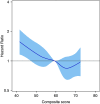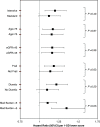Markers of Kidney Tubular Secretion and Risk of Adverse Events in SPRINT Participants with CKD
- PMID: 35973732
- PMCID: PMC9528325
- DOI: 10.1681/ASN.2022010117
Markers of Kidney Tubular Secretion and Risk of Adverse Events in SPRINT Participants with CKD
Abstract
Background: Kidney tubular secretion is an essential mechanism for clearing many common antihypertensive drugs and other metabolites and toxins. It is unknown whether novel measures of tubular secretion are associated with adverse events (AEs) during hypertension treatment.
Methods: Among 2089 SPRINT (Systolic Blood Pressure Intervention Trial) participants with baseline eGFR <60 ml/min per 1.73 m2, we created a summary secretion score by averaging across the standardized spot urine-to-plasma ratios of ten novel endogenous tubular secretion measures, with lower urine-to-plasma ratios reflecting worse tubular secretion. Multivariable Cox proportional hazards models were used to evaluate associations between the secretion score and risk of a composite of prespecified serious AEs (hypotension, syncope, bradycardia, AKI, electrolyte abnormalities, and injurious falls). The follow-up protocol for SPRINT routinely assessed two laboratory monitoring AEs (hyperkalemia and hypokalemia).
Results: Overall, 30% of participants experienced at least one AE during a median follow-up of 3.0 years. In multivariable models adjusted for eGFR and albuminuria, lower (worse) secretion scores at baseline were associated with greater risk of the composite AE outcome (hazard ratio per 1-SD lower secretion score, 1.16; 95% confidence interval, 1.04 to 1.27). In analyses of the individual AEs, lower secretion score was associated with significantly greater risk of AKI, serious electrolyte abnormalities, and ambulatory hyperkalemia. Associations were similar across randomized treatment assignment groups.
Conclusion: Among SPRINT participants with CKD, worse tubular secretion was associated with greater risk of AEs, independent of eGFR and albuminuria.
Keywords: adverse events; biomarker; hypertension; tubular secretion.
Copyright © 2022 by the American Society of Nephrology.
Figures




Comment in
-
Assessing Tubular Function, an Ignored Component of CKD, Might Be a Difference Maker!J Am Soc Nephrol. 2022 Oct;33(10):1806-1808. doi: 10.1681/ASN.2022080946. Epub 2022 Sep 9. J Am Soc Nephrol. 2022. PMID: 36630518 Free PMC article. No abstract available.
Similar articles
-
Kidney tubule health, mineral metabolism and adverse events in persons with CKD in SPRINT.Nephrol Dial Transplant. 2022 Aug 22;37(9):1637-1646. doi: 10.1093/ndt/gfab255. Nephrol Dial Transplant. 2022. PMID: 34473302 Free PMC article. Clinical Trial.
-
Estimated Kidney Tubular Secretion and Kidney, Cardiovascular, and Mortality Outcomes in CKD: The Systolic Blood Pressure Intervention Trial.Kidney Med. 2022 Sep 23;4(12):100546. doi: 10.1016/j.xkme.2022.100546. eCollection 2022 Dec. Kidney Med. 2022. PMID: 36507053 Free PMC article.
-
Urine Markers of Kidney Tubule Cell Injury and Kidney Function Decline in SPRINT Trial Participants with CKD.Clin J Am Soc Nephrol. 2020 Mar 6;15(3):349-358. doi: 10.2215/CJN.02780319. Epub 2020 Feb 28. Clin J Am Soc Nephrol. 2020. PMID: 32111704 Free PMC article.
-
Markers of Kidney Tubule Dysfunction and Major Adverse Kidney Events.Nephron. 2023;147(12):713-716. doi: 10.1159/000531946. Epub 2023 Jul 31. Nephron. 2023. PMID: 37524063 Review.
-
SPRINT and the Kidney: What Have We Learned?Curr Hypertens Rep. 2018 Sep 14;20(11):95. doi: 10.1007/s11906-018-0895-6. Curr Hypertens Rep. 2018. PMID: 30218213 Review.
Cited by
-
Assessing Tubular Function, an Ignored Component of CKD, Might Be a Difference Maker!J Am Soc Nephrol. 2022 Oct;33(10):1806-1808. doi: 10.1681/ASN.2022080946. Epub 2022 Sep 9. J Am Soc Nephrol. 2022. PMID: 36630518 Free PMC article. No abstract available.
-
Markers of Kidney Tubule Secretion and Future Risk of Sepsis-Associated Acute Kidney Injury Among REGARDS Participants.Kidney Med. 2025 Jun 16;7(8):101044. doi: 10.1016/j.xkme.2025.101044. eCollection 2025 Aug. Kidney Med. 2025. PMID: 40740725 Free PMC article. No abstract available.
References
-
- Forouzanfar MH, Liu P, Roth GA, Ng M, Biryukov S, Marczak L, et al. : Global burden of hypertension and systolic blood pressure of at least 110 to 115 mm Hg, 1990–2015. JAMA 317: 165–182, 2017 - PubMed
-
- Horowitz B, Miskulin D, Zager P: Epidemiology of hypertension in CKD. Adv Chronic Kidney Dis 22: 88–95, 2015 - PubMed
-
- Klag MJ, Whelton PK, Randall BL, Neaton JD, Brancati FL, Ford CE, et al. : Blood pressure and end-stage renal disease in men. N Engl J Med 334: 13–18, 1996 - PubMed
Publication types
MeSH terms
Substances
Grants and funding
- UL1 TR000433/TR/NCATS NIH HHS/United States
- UL1 TR000445/TR/NCATS NIH HHS/United States
- R01 DK098234/DK/NIDDK NIH HHS/United States
- UL1 TR000064/TR/NCATS NIH HHS/United States
- UL1 TR000075/TR/NCATS NIH HHS/United States
- IK2 BX004986/BX/BLRD VA/United States
- UL1 TR000093/TR/NCATS NIH HHS/United States
- UL1 TR000003/TR/NCATS NIH HHS/United States
- UL1 TR000050/TR/NCATS NIH HHS/United States
- UL1 TR001420/TR/NCATS NIH HHS/United States
- UL1 RR025755/RR/NCRR NIH HHS/United States
- HHSN268200900048C/HL/NHLBI NIH HHS/United States
- UL1 TR000005/TR/NCATS NIH HHS/United States
- P30 DK079337/DK/NIDDK NIH HHS/United States
- HHSN268200900040C/HL/NHLBI NIH HHS/United States
- K24 DK110427/DK/NIDDK NIH HHS/United States
- HHSN268200900046C/HL/NHLBI NIH HHS/United States
- P30 GM103337/GM/NIGMS NIH HHS/United States
- UL1 TR001064/TR/NCATS NIH HHS/United States
- UL1 RR025752/RR/NCRR NIH HHS/United States
- UL1 RR025771/RR/NCRR NIH HHS/United States
- HHSN268200900049C/HL/NHLBI NIH HHS/United States
- HHSN268200900047C/HL/NHLBI NIH HHS/United States
- UL1 TR000439/TR/NCATS NIH HHS/United States
- UL1 TR000073/TR/NCATS NIH HHS/United States
- UL1 TR000002/TR/NCATS NIH HHS/United States
- UL1 TR000105/TR/NCATS NIH HHS/United States
- UL1 RR024134/RR/NCRR NIH HHS/United States
- UL1 TR003142/TR/NCATS NIH HHS/United States
LinkOut - more resources
Full Text Sources
Medical
Research Materials
Miscellaneous

